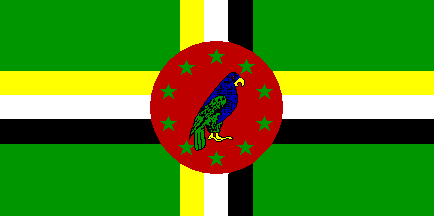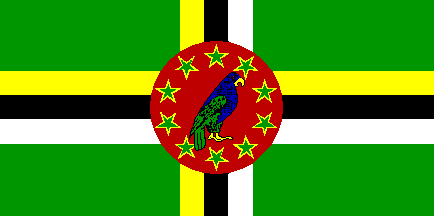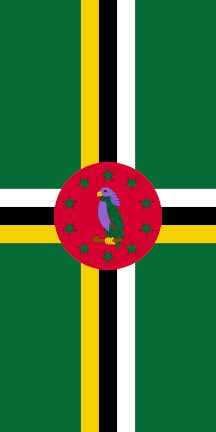 Flagge "Nationalflagge Dominica, Republik
(150 x 90 cm)" bei fahnenversand.de kaufen.
Flagge "Nationalflagge Dominica, Republik
(150 x 90 cm)" bei fahnenversand.de kaufen.
 Flagge "Nationalflagge Dominica, Republik
(150 x 90 cm)" bei fahnenversand.de kaufen.
Flagge "Nationalflagge Dominica, Republik
(150 x 90 cm)" bei fahnenversand.de kaufen.
Last modified: 2024-06-22 by rob raeside
Keywords: dominica | caribbean | america | parrot | sisserou parrot | star (10) | cross |
Links: FOTW homepage |
search |
disclaimer and copyright |
write us |
mirrors
 (1:2)
(1:2)  image by Zoltan Horvath, 24 May 2024
image by Zoltan Horvath, 24 May 2024
Official Name: Commonwealth of Dominica
Capital: Roseau
Flag adopted: 3
November 1978 (Modified 1988)
Coat of arms adopted: 21 July 1961
See also:
Other sites:
We say on our website: "The ten lime green stars - the
traditional symbol of hope - represent the ten parishes of the
country". According to Encyclopaedia Universalis
Yearbook, the ten parishes are: St. Andrew St. David, St.
George (including the capital city Roseau), St. John, St. Joseph,
St. Luke, St. Mark, St. Patrick, St. Paul and St. Peter.
Ivan Sache, 15 June 2004
I see the common name used in Dominica to call the parrot is Amazona
imperialis, followed by a scientific binomial name is Sisserou
Parrot (Psittacus Imperiala) (see Official
Announcement of the Flag at Independence). Zoologically,
nowadays the name "Psittacus imperialia" doesn't exist
and isn't accepted as the correct Linnaean name of the parrot is
Amazona imperialis, Richmond 1899. (The Genus Psittacus contains
just one species, which is Psittacus erithacus, Linnaeus 1758; the
African grey parrot).
Francesco Dalba, 28 September 2004
Some photos and a lot of descriptive text found (for instance) at www.rarespecies.org/imperial.htm
and www.worldparrottrust.org.
It seems, that this parrot is highly endangered (around 100
individuals left only).
M. Schmöger, 28 September 2004
From Official Website of the President's Office:
Ivan Sache, 15 November 2008
The national flag shown on a Dominican government site
is a former flag since order of triband and parrot's position are different from
present one and I found a present flag on the same website named Independence 25
at www.avirtualdominica.com.
The flag has yellow fimbriation to 10 stars.
The flag chart of U.N. members which I bought in U.N. h/o New York
in July 2003 shows yellow fimbriation, same as that of Dominican
government website Independence 25.
Nozomi Kariyasu, 5 and 8 May 2005
Now things are really getting complicated. The version at www.avirtualdominica.com
shows for the first time a parrot with a green head! Well, the living bird has a
blue-violet head. www.rarespecies.org and
same at the link "Our national symbols" at the same home page.
Here the yellow fimbriation is missing again. Nothing about this
in the explanation at this homepage.
J. Patrick Fischer, 5 May 2005
We have no details on the major features - we have several
different sizes for the cross and disk, differing versions of the
parrot, no size for the stars at all and the official
illustration which shows no fimbriation is in the wrong ratio.
I did have a copy of the official description for
"Lime and Forest Green":
Act No. 18 of 1978, The National Emblems of Dominica Act, signed
31 October 1978, gazetted 1 November 1978 and effective 3
November 1978.
The Schedule, Part II: "The following is a description of
the National Flag of Dominica:- Vert three pallets conjoined in
pale and as many bars similarly conjoined in fess or argent and
sable overall a roundel gules charged with a Sisserou Parrot
(Psittacus imperialis) facing sinister perched on a wooden twig
proper within a orle of ten mullets. Also vert."
The description of the arms gives further details on the parrot
as follows: "proper beaked and membered or" but as you
see no such description is given for the flag.
Just to add a little more to the prevailing confusion about this
flag, at the website
of the High Commission in London we have another image with
yellow fimbriation to the stars. This time the cross
is at 30% and the disk at 55% which gives us yet another layout.
Christopher Southworth, 6 May 2005
The Flag Bulletin XXII:/6/102" of November-December 1983
informs that "Exactly after three years of attainment of
independence - on 3 November 1981 - a revised form of the
national flag was introduced" and "the disk is
two-thirds the width of the flag".
Martin Grieve, 8 May 2005
When I prepared the 2nd edition of my book Lexikon vlajek a
znaku zemi sveta [brz98c]
in 2003, I tried to solve the problem of the yellow fimbriation
and sent several letters to Dominica. I got the answer from the
Dominica Academy of Arts & Sciences that the stars are
without the fimbriation in a letter of 25 July 2003.
Ales Brozek, 9 May 2005
Roberto Breschi has very kindly sent me a copy of the 1991
Article from The Flag Bulletin on this very subject, and this
says that: "The parrot had its colouring modified to
correspond more closely to the appearance of the national bird
(the Sisserou or imperial parrot). The stars surrounding the bird
originally were 'lime green' instead of the dark green of the
flag background. In the second and third versions of the flag the
stars became dark green but had fimbriations in
yellow. These fimbriations, not mentioned in the
official blazon, have now been omitted".
In the meantime there seems no doubt that the stars no longer
have a yellow fimbriation, and (something of which I was also
unaware) that the stars became dark green between 1981 and
1988.
Christopher Southworth, 9 May 2005
The protocol manual for the
London 2012 Olympics
(Flags and Anthems Manual
London 2012 [loc12]) provides recommendations
for national flag designs. Each
NOC
was sent an image of the flag, including the
PMS shades, for their approval by LOCOG. Once this was obtained, LOCOG produced
a 60 x 90 cm version of the flag for further approval. So, while these specs may
not be the official, government, version of each flag, they are certainly what
the NOC
believed the flag to be.
For Dominica: PMS 347 green, 185 red, 116 yellow, 254 purple, 430 grey and
black. The vertical flag is simply the horizontal version turned 90 degrees
clockwise.
Ian Sumner, 10 October 2012
The Flag Manual - Beijing 2008 gives Pantone colors: PMS 603 (yellow), PMS
703 (red), PMS 258 (purple), PMS 363 (green), PMS 430 (gray), and PMS Black.
The Album des Pavillons 2000 [pay00] gives
approximate colors in Pantone and CMYK systems:
Green: Pantone 347c, CMYK
100-0-80-0
Red: Pantone 185c, CMYK 0-90-75-0
Yellow: Pantone 116c, CMYK
0-15-95-0
Purple: Pantone 254c, CMYK 50-95-0-0
The Album des Pavillons
2023 already specifies the colors of the flags in three color systems.
Purple: Pantone 2070c, CMYK 56-91-0-0, RGB 150-35-153
Red: Pantone 186c, CMYK
14-100-79-4, RGB 200-16-46
Yellow: Pantone 116c, CMYK 0-21-93-0, RGB
255-204-0
Green: Pantone 347c, CMYK 81-12-76-1, RGB 22-155-98
Vexilla Mundi gives colors in Pantone
system: PMS 349C(green), PMS 199C (red), PMS 116C (yellow), PMS Black, PMS
White, and PMS 265C (purple)
Wikipedia doesn’t give any color
specification, but provides a construction sheet:
https://commons.wikimedia.org/wiki/File:Flag_of_Dominica_(construction_sheet).svg
Flag Color Codes gives the
following color values:
Green: Hex # 009A44, RGB 0-154-68, CMYK
92-0-97-0, Pantone 347, RAL 6024
Yellow: Hex FFCD00, RGB 255-205-0, CMYK
0-10-98-0, Pantone 116, RAL 2007
Black: Hex # 000000, RGB 0-0-0, CMYK
0-0-0-100, Pantone Black, RAL 9005
White: Hex # FFF FFF, RGB 255-255-255,
CMYK 0-0-0-0, Pantone N/A, RAL N/A
Red: Hex # E4002B, RGB 228-0-43, CMYK
0-100-89-0, Pantone 185, RAL 3026
Purple: Hex # 981E97, RGB 152-30-151,
CMYK 46-98-0-0, Pantone 254, RAL 4006
Zoltan Horvath, 24 May 2024
 image by Herman De Wael, 8 June 1997
image by Herman De Wael, 8 June 1997
 image by Herman De Wael, 8 June 1997
image by Herman De Wael, 8 June 1997
First adopted 3 November 1978. Black and white bands
interchanged on 3 November 1981, posture of parrot changed 1988.
Originally the stars had no yellow border.
Mark Sensen , 2 January 1996
 (1:2)
(1:2)  image by Carlos Esparza, 9 February 2001
image by Carlos Esparza, 9 February 2001
The flag of Dominica was last modified on 3 November 1990, when yellow
fimbriation around the stars removed.
Zoltan Horvath, 24 May 2024
From Album 2000 [pay00] -
National Flag (CSW/CSW 1:2) - Green flag with yellow-black-white
cross and red disk with 10 yellow bordered green stars and
Sisserou parrot (looking towards hoist). The construction details
are given beside the figure as (9+2+2+2+9):(21+2+2+2+21).
Measuring the image in Album 2000, the disk diameter appears to be
equal to 12 units (i.e. double the three stripes width). It is
hard to judge the size of the stars, they appear to be inscribed
in circles larger then 2 units, but whether they are 3x, I
couldn't say. Maybe the document from which Armand got the rest
of the construction would say more. I doubt that the size of
yellow border is prescribed. The use of unusual colours in this
flag might be a good reason to
quote the colour approximation provided in Album: green Pantone
347c, red Pantone 185c. yellow Pantone 116c and purple Pantone
254c.
Željko Heimer, 15 June 2001
Is there some branch under the parrot and what is the
orientation of stars?
Note: The Sisserou parrot is, scientifically, Amazona Imperialis.
Jan Zrzavy, 16 June 2001
The image by Carlos Esparza is very well done regarding the
details in the disk (however, the cross is not quite according to
the Album specification, though). So the stars are pointing
"outwards" but that virtually means that the topmost
star is pointing upwards and then interchangeably next one is
pointing downwards, and next one upwards again and so on. There
is a yellow branch on which the parrot is sitting (not brownish
as by Carlos). The beak and "fingers" are white (or
very light yellow?) in Album, and those parts that are in Carlo's
image blue are purple in Album. There should not be the small
green part between the two purple parts (near the beak) - all
should be purple there.
I always wondered - Dominica was under British colonial
influence, so how come that they never adopted anything similar
to the British flags & ensigns system?
Željko Heimer, 16 June 2001
The new Dominica independence flag is now on display at Government headquarters. Dominicans are invited to view the flag on the third floor of the building.
The flag in an amendment of a design submitted by Alwin Bully for a flag competition held early this year. It consists of a circular emblem of red bearing a Sisserou Parrot (Psittacus imperiala) standing on a twig encircled by ten lime green stars. This is superimposed on three vertical and three horizontal stripes of yellow, white and black forming a triple coloured cross against a general background of forest green.
The central emblem presents the National Bird of Dominica, the Sisserou Parrot, also a symbol of flight towards greater heights and fulfillment of aspirations. The Parrot also comes from the Dominica Coat of Arms thus symbolising the official seal of the country.
The ten lime green stars - the traditional symbol of hope - represent the ten parishes of the country, each with equal status, thus the equality of our people. The red central emblem carries the connotation of socialism.
The yellow, white and black stripes form a triple coloured cross representing the Trinity of God. The cross itself demonstrates belief in God since the Commonwealth of Dominica is founded upon principles that acknowledge the supremacy of God.
The yellow stripe represents the sunshine of our land, our main agricultural products: citrus and bananas and also a symbol of the Carib people, the first inhabitants of the Island.
The white stripe represents the clarity of our rivers and waterfalls and the purity of aspiration of our people.
The black stripe represents the rich black soil of our island on which our agriculture is based and also our African heritage.
The general background of dark green symbolises our rich verdant forests and the general lushness of the island.
The flag can be seen during normal working hours. Citizens may, if they so desire, use the colours of the flag for making buntings to decorate their houses and surroundings during Independence Celebrations.
"The army loyal to the Prime Minister Mary Eugenia Charles represses a revolt lead by the ex-commander-in-chief of Dominican Army Frederik Newton and by his vice Ashton Benjamin; they are arrested together with more than 90 people. The rebels tried to assail the prison in which there was the ex-Prime Minister Patrick John, who was arrested on 12 February 1981"
So I argue that the little change of the flag is someway related
with the change of government happened in the same year.
Giuseppe Bottasini
 image by Zoltan Horvath, 24 May 2024
image by Zoltan Horvath, 24 May 2024
The flag is hung with the reverse showing, but the parrot
retains the original position.
Graham Bartram and Željko Heimer, 7 August
1996
Dominica is divided to 10 parishes. There are no known flags
of those parishes. The parishes are:
- Saint Andrew
- Saint David
- Saint George
- Saint John
- Saint Joseph
- Saint Luke
- Saint Mark
- Saint Patrick
- Saint Paul
- Saint Peter
List based on Administrative
divisions of the World.
Ivan Sache, 15 June 2004
I take it that these are governmental designations rather than
ecumenical (i.e., the parishes are not literally church parishes,
but are administrative divisions).
James Dignan, 15 June 2004
They are listed in Encyclopaedia Universalis Yearbook as
administrative divisions but they probably match church
divisions. Religion seems to be very important in those Caribbean
islands and it is not so surprising that the administrative
divisions are called parishes.
Ivan Sache, 16 June 2004







